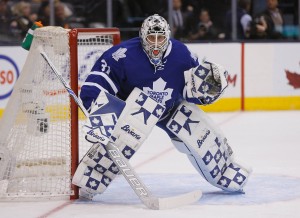The Toronto Maple Leafs have been very quiet this summer. The majority of activity happened during the 2016 NHL Entry Draft with drafting Auston Matthews and later acquiring Frederik Andersen from the Anaheim Ducks, which was followed by signing Matt Martin and Roman Polak. The Leafs had filled out their roster but were still missing a backup goalie after Jonathan Bernier was traded, which prompted management to confirm that a backup would be acquired before the start of the season. That was reiterated by head coach Mike Babcock shortly after the Andersen deal, “Now we have to find a good pro to come in and support him, and we’ll do that”.
With only a month until the start of the pre-season, it looked like Garret Sparks would be put into the backup role, but the Leafs lived up to their promise and signed Jhonas Enroth as their backup goalie.
The Best Option

There wasn’t really much of a choice in signing Enroth when looking at the other options for the Leafs. The first one would be making Sparks the backup goalie, but that really wouldn’t have been beneficial to Sparks or the Leafs. Even though Sparks had a great start with the Leafs last season it quickly became clear that he was far from being an NHL goalie. At only 23 years old he has lots of time and room for improvement, which makes Sparks better off in the AHL.
Then there was the large group of unwanted goalies to choose from in free agency. The choices seemed to be either an older goalie that is well past his prime or a goalie that is younger but has struggled in the backup role. Enroth came out being the best option in terms of skill and longevity in the NHL. Half of the free agent options will most likely retire in the next year which isn’t what the Leafs need. The Leafs need to be able to give their AHL goalies time to develop properly without having to be forced into the NHL when they aren’t ready.
Jhonas Enroth Gives the Leafs Flexibility
The lack of demand for goalies this offseason helped the Leafs sign a fantastic deal with Enroth for a one-year contract for $750,000. Not only does this keep the Leafs under the cap ceiling (before long-term injury reserve comes into effect), but it also gives them options at the trade deadline if they choose to trade Enroth.
As stated earlier, Enroth can give the Leafs AHL goalies time to develop for a few years before they make the jump to the NHL. And if it doesn’t work out for Enroth then it really doesn’t cost the Leafs anything in the long-term since they won’t be restrained by a long-term contract.
It’s very similar to when the Leafs signed Brad Boyes last season to almost the same contract. He played well last year, but didn’t end up being part of the Leafs long-term plans and wasn’t re-signed. The same thing could happen with Enroth, but what it does is give the Leafs a year to find a better alternative as the backup goalie and if they can’t then bringing Enroth back is also an option.
This isn’t the type of signing that will significantly impact the season for the Leafs, but what it does is give the Leafs a decent backup goalie at an extremely small cost and doesn’t restrict future goaltending decisions.